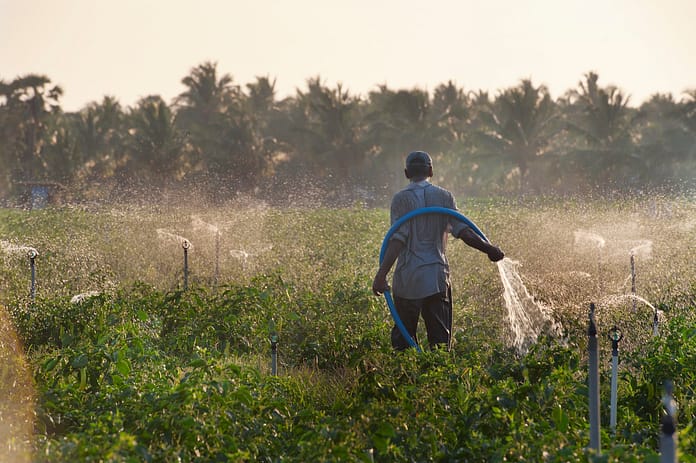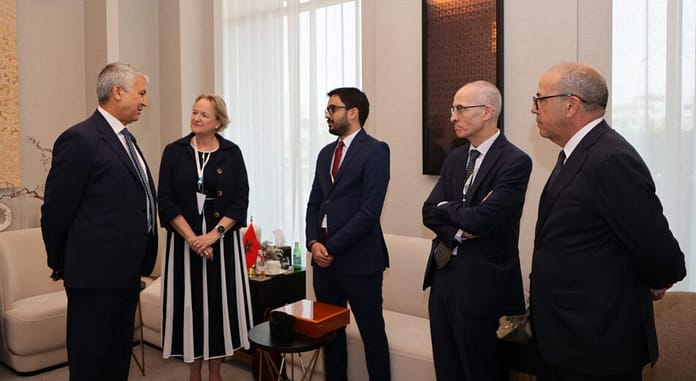

International Water Management Institute (IWMI) researchers Maha Al-Zu’bi and Zafar Gafurov have been selected as lead authors of the Intergovernmental Panel on Climate Change’s (IPCC) Seventh Assessment Report. The IPCC is a scientific body convened by the United Nations, now at the start of its seventh assessment cycle, which is expected to conclude in 2029. Since 1988, the IPCC has gathered scientists from across the globe to present the state of knowledge on climate change for policymakers, enabling governments to design policies and make decisions with a full understanding of climate implications. Over 3,700 scientists were nominated this cycle, resulting in a diverse cohort of 664 lead authors and review editors representing 111 countries.
13 of these lead authors are from CGIAR, forming the largest cohort of authors from one organization. For the first time, two lead authors from IWMI will provide their expertise to the working group “Impacts, Adaptation and Vulnerability.” Gafurov is a lead author for the chapter on Asia, and Al-Zu’bi is a lead author for a chapter on water. Over the next four years — the time it takes to draft the report — they will be driving the research and writing behind this critical effort to understand climate change and the potential for policy responses.
In this conversation, IWMI caught up with Gafurov and Al-Zu’bi to unpack their plans for the Seventh Assessment Report (AR7). Al-Zu’bi is a regional researcher in IWMI’s Egypt office working on sustainable and resilient water systems, while Gafurov is a regional researcher on climate change, data science, earth observation and renewable energy based in IWMI’s Uzbekistan office.
You have been selected as lead authors for Working Group II, which focuses on impacts, adaptation and vulnerability. Can you explain what your specific chapters will tackle?
Al-Zu’bi: The chapter on water examines how climate change affects water availability, quality and management. We will explore how adaptation strategies can meet the needs of people, agriculture and ecosystems. We focus on four main areas: ensuring water security under changing conditions, managing water across sectors using systemic approaches, coordinating transboundary and multi-level water governance, and assessing risks or unintended consequences from adaptation measures.
Gafurov: For the chapter on Asia, I will contribute my expertise from my ongoing research on climate data sets and the impacts of climate change across Asia — in particular, Central Asia. We will assess the interlinked effects of climate change across diverse ecosystems, societies and economies. We will pay attention to hot- spots where climate impacts intersect strongly with human development, across river basins, mountains and coastal areas.
What are the key challenges you anticipate in demonstrating climate change’s impact on the water cycle?
Al-Zu’bi: One of the main challenges is attribution — separating the impacts of climate change from natural variability and human-driven changes like land use or water withdrawals. Data gaps, especially in long-term hydrological records, make it harder to detect trends. There is also the issue of scale mismatches. Global models often cannot capture fine-scale local processes and compounding events like droughts and floods, which interact with human systems in complex ways. Addressing these challenges requires integrating multiple lines of evidence, including models and case studies, while being transparent about uncertainties.
What does this opportunity to be a lead author mean to you personally and professionally?
Al-Zu’bi: Being a lead author is both an honor and a responsibility. It allows me to contribute rigorous scientific knowledge on water and climate directly to policymakers, practitioners and researchers worldwide. Personally, it is also an inspiration: I hope it encourages other female scientists in the Middle East and North Africa, showing that with dedication and excellence, they too can make a meaningful impact and grow in their careers.
Gafurov: Echoing Maha, being a lead author is indeed both a professional honor and a responsibility. Personally, amplifying voices from Central Asia in the global arena means I can be a bridge for information from the region, ensuring challenges and solutions are visible in the international climate dialogue.
At IWMI, you work on transboundary river issues in Uzbekistan and Kyrgyzstan. How does that localized experience shape your contribution to the IPCC’s global assessment of water challenges?
Al-Zu’bi: When working on localized transboundary water issues, the focus is very context-specific. It requires detailed engagement with stakeholders, understanding institutional frameworks and tailoring solutions to local political, social and ecological conditions. Co-authoring an AR7 chapter, in contrast, involves synthesizing evidence across regions and scales, identifying patterns and assessing adaptation options globally. My field experience informs the IPCC chapter by grounding global evidence in real-world challenges, while the global perspective helps highlight lessons and strategies that can be applied across different contexts.
Given the increasing climate impacts across Asia, how has the urgency of your work changed?
Gafurov: Events such as the recent floods in Pakistan highlight that climate change is not a distant risk — it is a current reality. They add urgency to ensure our assessments are evidence-based and policy-relevant. Through AR7, we can help governments and communities take prompt actions if we sufficiently link research with stakeholders and policymakers to pass along meaningful information on potential solutions, to overcome climate disasters.
How does your background in remote sensing and geographic information systems (GIS) influence your approach to writing the chapter on Asia?
Gafurov: Climate does not have a border. Remote sensing and GIS are powerful tools to overcome challenges in assessing climate change in regions with limited data. Remote sensing can capture climate impacts across national boundaries in terms of glacier retreats, droughts, land use changes and water resource uses. Such data are vital for evidence-based assessments in the geographically diverse regions of Asia, as this chapter will consider not only national issues but also the transboundary challenges of climate change.
The UN originally designed the IPCC assessments to provide scientific information on climate change to policymakers. In the 37 years since its inception, IPCC reporting has reached decision-makers, enterprises, academics and the wider public. What considerations do you make when writing for such a broad audience?
Al-Zu’bi: Scientific knowledge has the greatest impact when it is accessible and actionable. When writing for a diverse audience, I balance scientific rigor with clarity. This involves using layered communication: clear headline messages for non-specialists, plain-language summaries for practitioners and detailed technical annexes for experts. Equity, vulnerability and real-world relevance are key considerations to ensure the chapter resonates across stakeholders, sectors and regions.
How can organizations such as IWMI ensure that findings from AR7 translate into actionable policy in the countries we work in?
Gafurov: Connected to both global assessments and local realities, partner organizations can help contextualize the findings of the IPCC report through regional research, policy dialogues and capacity building. IWMI can spark meaningful discussions within local communities and help governments translate knowledge into practical strategies.
Al-Zu’bi: Organizations like IWMI can bridge the gap between global science and local action in a few ways. They can tailor policy briefs and decision-support tools to country-specific contexts and engage stakeholders early through workshops and sessions to interpret findings. Organizations can also demonstrate solutions through pilot projects and embed monitoring and evaluation frameworks, as IWMI does, to track adaptation impacts and link evidence to investment and regulatory decisions.
What makes you optimistic about the future of climate change adaptation and mitigation?
Gafurov: There is a global recognition that climate change is happening and that we need to curtail global warming. But various regions have struggled to take action. What interests me is how we can push governments to really think about minimizing greenhouse gases and other mitigation efforts. How can we move forward with a clear plan and vision for the future, for 2050 or 2200, considering how governments act upon the information within the assessment reports?
Al-Zu’bi: What drives me is that we cannot deny it anymore — we are already experiencing climate change, though some people still attempt to disbelieve this. It has been a difficult year with hurricanes, floods and droughts across the globe. I see many opportunities for governments to reflect on this reality, and this is what keeps me optimistic. My hope is that more people will realize this is not a joke, that climate change is proven, and engage in collective action: not only scientists, but policymakers. Things can change. When I recall 30 years ago, when the first IPCC report was published, fewer people were reading and referring to it. But now, between every event, conference, paper and newsletter, everyone is referencing these important reports.
















